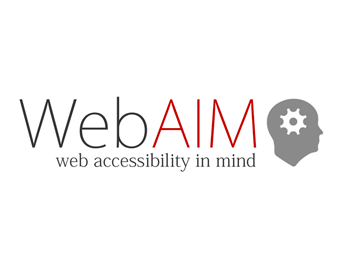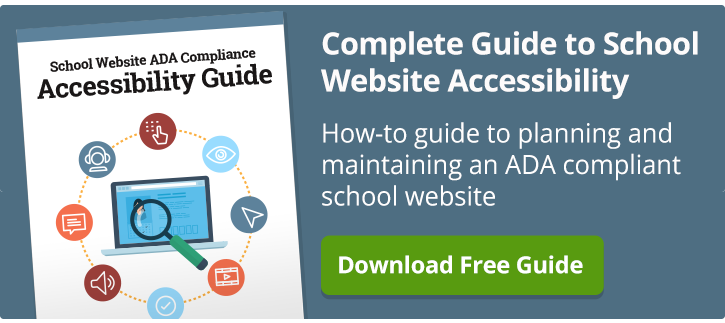The following questions were posed during a recent SchoolNow Academy webinar on web accessibility that was presented by Jared Smith, the Associate Director of WebAIM. WebAIM is the Web Accessibility in Mind project at the Center for Persons with Disabilities at Utah State University. To view a recorded version of Jared's webinar, go here.
The WebAIM.org web site has a wealth of information to help you learn more about implementing and evaluating web site accessibility.
Website accessibility and ADA compliance for school districts is an especially important topic, as school administrators seek to do not only the right thing, but the legal thing. Disability advocacy groups across the country have filed complaints with the Department of Education's Office of Civil Rights OCR asking school districts to comply with the law.
The OCR resolution agreements vary, but the task facing many school districts is to get their websites accessible. How to go about making school website accessible can be a daunting process that is ongoing.
Here are the questions and answers we did not have time to get to during the SchoolNow Academy webinar:
Q: What about embedded content, such as a Google calendar or a Facebook feed? I'm having trouble getting screen readers to recognize the calendar.
JS: Screen readers generally have access to embedded content, so this may be an issue with your usage of the screen reader, or it may suggest significant accessibility issues with this content. I’ve not experienced such issues with this type of content, so it likely is something on your end.
Q: Can an iframe be placed in a web page, and if so, are there guidelines to follow?
JS: Yes, there are no inherent issues with using iframes. The iframe content will be read as part of the page that contains it. If the iframe presents a distinct block of content, such as an advertisement or a video player, then you can give the <iframe> element a title attribute value that describes the content. More details are available at: https://webaim.org/techniques/frames/#iframe
Q: Are the WCAG 2.0 guidelines applicable to all websites or only public school district sites?
JS: WCAG functions independent of the nature of the site. It is simply a way to measure accessibility of any web site. Legal or contractual requirements may vary based on the content or nature of the site, and some may require WCAG conformance, but WCAG itself does not define a scope for applicability.
Q: Can PDF documents be read by a screen reader?
JS: HTML documents support a much higher level of accessibility and are generally much easier to make accessible and to provide to users than PDF documents, but PDF documents can be made highly accessible. More details are available at: https://webaim.org/techniques/acrobat/
Q: Question about Image Alt tags... how detailed should we get describing a picture (placed for design) or a headshot of an individual?
JS: There are two key words to remember - Content and Function. You want to present the core content of the image and, if it is clickable, what the function is. You do not want to describe what a picture looks like. One question that can be helpful when considering proper alternative text is “If I could not use this image, what text would I put in its place?”. For a headshot image, typically the person’s name is sufficient for alternative text.
Q: Are there any smartphone apps subject to accessibility requirements
JS: Section 508 applies to “Electronic and Information Technology”, so this certainly covers mobile apps. The ADA has yet to define technical standards for such things (including web content), but several complaints and lawsuits have suggested that inaccessible apps are considered discriminatory under ADA.
Q: Do you have any experience with Vimeo as compared to YouTube?
JS: Vimeo has historically had poorer support for accessibility of their player and support for captions than YouTube, though Vimeo does currently support good accessibility for such things, though not to the same level as YouTube.
Q: Are charter schools and private schools required to be compliant in the same way public schools are?
JS: I can’t speak definitively to the legal requirements except to note that discrimination laws clearly apply to such entities. Public entities have clearer requirements, particularly because they receive federal funding, but I do not believe that charter or private schools are exempt.
Q: Do schools need to make special considerations for social media platforms (Facebook, Twitter, Instagram, etc.)?
JS: Social media is often a primary mechanism for communication and information dissemination for schools. Even though schools cannot control the accessibility of such platforms, this does not mean that they are exempt from needing to ensure that content delivered via these platforms be accessible.
Q: Can you recommend companies or organizations that can coordinate website compliance?
JS: WebAIM can help you navigate the website compliance process.
Q: Is this school website accessibility presentation in a handout?
Yes, both the slides and video presentation can be found here.
Q: If we embed a YouTube video into the website, doesn't YouTube automatically handle the accessibility issues?
JS: Yes, at least partially. The YouTube video player has acceptable accessibility, however the video author is still responsible to provide captions for the media.
Q: Does WebAIM provide a service to test for accessibility, broken links and spelling errors?
JS: We do provide the free WAVE accessibility testing accessibility service - https://wave.webaim.org/ This tool focuses on accessibility and does not test broken links, spelling, etc.
Q: Must transcripts have to be created for the entire website, or just multi-media portions?
JS: Transcripts are only relevant to video and audio content. Users with disabilities can read text content from other portions of the site.
Thanks again to Jared Smith, Associate Director of the WebAIM (Web Accessibility in Mind) project at the Center for Persons with Disabilities at Utah State University, for leading this informative webinar.
Additional school website accessibility and ADA-compliance resources:
- Archived version of Jared Smith's web accessibility for schools webinar presented by the SchoolNow Academy.
- The Complete Guide to School Website Accessibility
- WebAIM – the Web Accessibility in Mind project
Other related articles:
Topics: Website accessibility Campus Suite news
About the author
Marketing director and content strategist for SchoolNow, Jay’s a former school public relations specialist who’s helped businesses, schools and colleges use the power of communications to improve their image, generate support, and optimize relationships. Reach him at jay@schoolnow.com.
.png?width=64&height=63&name=Group%20(4).png)
.png?width=66&height=64&name=Group%20(5).png)
.png?width=56&height=60&name=Group%20(6).png)
.png?width=66&height=52&name=Group%20(7).png)
.png?width=56&height=56&name=Group%20(9).png)
.png?width=59&height=52&name=Group%20(10).png)


